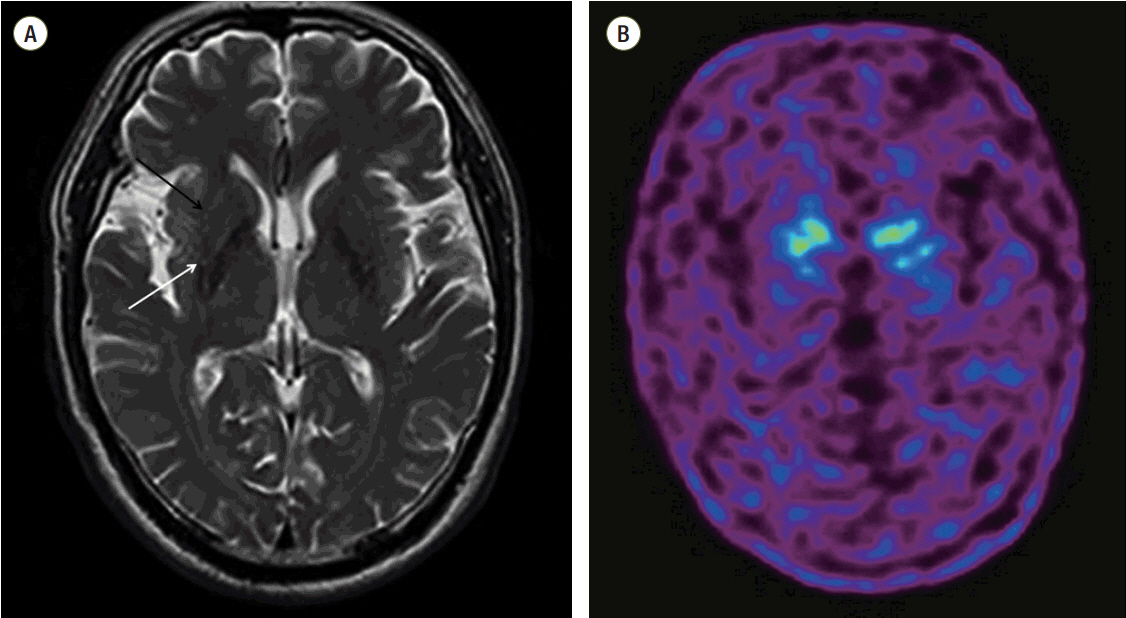Korean J Crit Care Med.
2015 May;30(2):123-127. 10.4266/kjccm.2015.30.2.123.
Multiple System Atrophy Manifested by Bilateral Vocal Cord Palsy as an Initial Sign
- Affiliations
-
- 1Department of Internal Medicine, Asan Medical Center, University of Ulsan College of Medicine, Seoul, Korea.
- 2Department of Neurology, Asan Medical Center, University of Ulsan College of Medicine, Seoul, Korea.
- 3Department of Pulmonary and Critical Care Medicine, Asan Medical Center, University of Ulsan College of Medicine, Seoul, Korea. yskoh@amc.seoul.kr
- KMID: 2227681
- DOI: http://doi.org/10.4266/kjccm.2015.30.2.123
Abstract
- A 71-year-old male initially presented with vocal cord palsy and underwent tracheostomy. After thorough examination, urogenital dysfunction, orthostatic hypotension, and Parkinsonism were found, which led to the diagnosis of multiple system atrophy (MSA). After the tracheostomy, bi-level positive airway pressure ventilation was required during the night due to nocturnal hypoxemia. Night-time hypoxemia is related to central sleep apnea, which is one of the manifestations of MSA. This is the first case of MSA manifested by bilateral vocal cord palsy as an initial sign in Korea. This case supports the notion that MSA should be taken into consideration when vocal cord paralysis is observed.
MeSH Terms
Figure
Reference
-
References
1. Egami N, Inoue A, Osanai R, Kitahara N, Kaga K. Vocal cord abductor paralysis in multiple system atrophy: a case report. Acta Otolaryngol Suppl. 2007; (559):164–7.
Article2. Gilman S, Wenning GK, Low PA, Brooks DJ, Mathias CJ, Trojanowski JQ, et al. Second consensus statement on the diagnosis of multiple system atrophy. Neurology. 2008; 71:670–6.
Article3. Stefanova N, Bücke P, Duerr S, Wenning GK. Multiple system atrophy: an update. Lancet Neurol. 2009; 8:1172–8.
Article4. Uzawa A, Sakakibara R, Tamura N, Asahina M, Yamanaka Y, Uchiyama T, et al. Laryngeal abductor paralysis can be a solitary manifestation of multiple system atrophy. J Neurol Neurosurg Psychiatry. 2005; 76:1739–41.
Article5. Deguchi K, Ikeda K, Shimamura M, Urai Y, Tsukaguchi M, Touge T, et al. Assessment of autonomic dysfunction of multiple system atrophy with laryngeal abductor paralysis as an early manifestation. Clin Neurol Neurosurg. 2007; 109:892–5.
Article6. Schulz JB, Klockgether T, Dichgans J. Bilateral vocal cord paralysis in multiple-system atrophy (MSA). Aktuelle Neurologie. 1993; 20:170–3.7. Jecmenica-Lukic M, Poewe W, Tolosa E, Wenning GK. Premotor signs and symptoms of multiple system atrophy. Lancet Neurol. 2012; 11:361–8.
Article8. Wu YR, Chen CM, Ro LS, Chen ST, Tang LM. Vocal cord paralysis as an initial sign of multiple system atrophy in the central nervous system. J Formosan Med Assoc. 1996; 95:804–6.9. Nonaka M, Imai T, Shintani T, Kawamata M, Chiba S, Matsumoto H. Non-invasive positive pressure ventilation for laryngeal contraction disorder during sleep in multiple system atrophy. J Neurol Sci. 2006; 247:53–8.
Article10. Isozaki E, Osanai R, Horiguchi S, Hayashida T, Hirose K, Tanabe H. Laryngeal electromyography with separated surface electrodes in patients with multiple system atrophy presenting with vocal cord paralysis. J Neurol. 1994; 241:551–6.
Article11. Isono S, Shiba K, Yamaguchi M, Tanaka A, Hattori T, Konno A, et al. Pathogenesis of laryngeal narrowing in patients with multiple system atrophy. J Physiol. 2001; 536(Pt 1):237–49.
Article12. Shiba K, Isono S, Nakazawa K. Paradoxical vocal cord motion: a review focused on multiple system atrophy. Auris Nasus Larynx. 2007; 34:443–52.
Article13. Bannister R, Gibson W, Michaels L, Oppenheimer DR. Laryngeal abductor paralysis in multiple system atrophy. A report on three necropsied cases, with observations on the laryngeal muscles and the nuclei ambigui. Brain. 1981; 104:351–68.14. DeReuck J, Van Landegem W. The posterior cricoarytenoid muscle in two cases of Shy-Drager syndrome with laryngeal stridor. Comparison of the histological, histochemical and biometric findings. J Neurol. 1987; 234:187–90.15. Beck RO, Betts CD, Fowler CJ. Genitourinary dysfunction in multiple system atrophy: clinical features and treatment in 62 cases. J Urol. 1994; 151:1336–41.
Article16. Deguchi K, Ikeda K, Goto R, Tsukaguchi M, Urai Y, Kurokohchi K, et al. The close relationship between life-threatening breathing disorders and urine storage dysfunction in multiple system atrophy. J Neurol. 2010; 257:1287–92.
Article
- Full Text Links
- Actions
-
Cited
- CITED
-
- Close
- Share
- Similar articles
-
- A Case of Bilateral Vocal Cord Paralysis from Progressive Supranuclear Palsy
- Bilateral vocal cord palsy in a post-anesthesia care unit after total thyroidectomy: A case report
- Bilateral vocal cord palsy after removal of falx meningioma in the hyperflexion of the neck: A case report
- Bilateral Vocal Cord Palsy Associated with Multiple Symmetrical Lipomatosis(Madelung's Disease)
- LASER Medial Arytenoidectomy in Two Patients of Bilateral Vocal Cord Palsy



